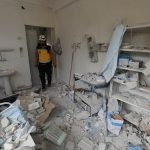Bombed out emergency rooms. Destroyed maternity wards. Wrecked ambulances. Dead medical professionals. This is what the already beleaguered civilian population in Syria’s northwest is enduring following a ferocious renewal of systematic attacks on medical infrastructure.
These atrocities are not one-offs. Instead, as documented by Physicians for Human Rights (PHR), the bombing of health facilities to put them out of service is a field-tested tactic that is part of a broader strategy aimed at achieving military gains through the collective punishment of civilians, regardless of the human toll. It was particularly effective across a range of locations the Syrian regime has managed to recapture over the past few years, including Aleppo and Eastern Ghouta. Now we’re seeing it being reapplied wholesale in Syria’s northwest – an area with an estimated population of three million civilians, nearly half of whom were displaced from other locations across the country.
In this latest round of targeted violence centered on northern Hama and Idlib, humanitarian and civil society organizations have reported that the Syrian government and its Russian allies have carried out no fewer than 20 attacks on health facilities since April 26. PHR has been able to document nine of those attacks so far – all of which were perpetrated by the government and its allies – and continues to research previous and emerging reports.
Dr. Munther al-Khalil, head of the Idlib Health Directorate, made clear in a recent communication to PHR that the attacks were systematic and calculated: “The Syrian government and its allies are not only targeting medical facilities in towns they’re on the verge of recapturing. They’re also hitting ambulances, hospitals, and clinics along the principle evacuation routes out of northern Hama and southern Idlib toward central Idlib. These are the facilities to which the sick and injured were supposed to be evacuated. They’re not just destroying individual facilities here, they’re actually targeting our entire referral grid.”
The attacks have taken out surgical hospitals, primary health care centers, and specialized facilities, turning entire areas that the Syrian government is targeting into medical deserts bereft of services that the population desperately needs. As a matter of staff and patient safety, many facilities that were not targeted have suspended their activities. According to local health officials, 12 primary health care centers and 21 vaccination centers in the northwest have suspended their activities for fear of being attacked. According to the most recent figures, the facilities that went offline as a direct or indirect result of the escalation in violence provided over 171,000 outpatient consultations, 2,760 major surgeries, and 1,424 deliveries per month.
The Syrian government and its allies targeted at least three facilities whose coordinates were shared with parties to the conflict through the UN’s deconfliction mechanism. In addition, many of the facilities hit during the current wave of violence had been attacked and taken out of service multiple times before. The Kafr Zeita Cave Hospital, an underground facility registered with the deconfliction mechanism that PHR recently researched to highlight the intentionality of such attacks, was targeted and went out of service for the seventh time since 2016 on May 5.
“We’re doing what we can to adapt, but the challenges seem insurmountable” said Dr. Khalil. “At this point, we can’t restore any of the facilities that were hit. We tried in Kafr Nabl, but as soon as the hospital was back in service it was targeted again” he added, referring to the Kafr Nabl Surgical Hospital, which was targeted on May 5, brought back online, only to be hit again five days later. That would make it the eleventh time this facility was attacked since 2014. Dr. Khalil added, “We’re trying to establish small surgical units in affected communities, if only for the purpose of damage control, but people are rejecting the idea. They’re afraid of being near medical facilities.”
Fear of being near medical facilities. This is an anxiety that has become all too common among many Syrians. Years of relentless attacks on health have effectively twisted basic conceptual associations to the point that hospitals and clinics have become fundamentally linked to insecurity and death rather than to safety and life, especially when they are most needed – that is, in times of heightened violence.
Since the beginning of the conflict in Syria, PHR has documented 566 attacks on at least 350 health facilities, over 90 percent of which were carried out by the Syrian government and its allies, including non-state armed groups and the Russian armed forces. These attacks have been so pervasive as to become predictable. Any military escalation by the Syrian government and its allies can be expected to be accompanied by a surge in attacks on health facilities. Violently stripping people’s access to health is as elemental to the Syrian government’s military strategy as the indiscriminate bombing of population centers. What is happening now in Idlib is the latest testament to the deliberate nature of attacks on health in Syria and their appalling health and safety consequences on civilians.
The United Nations Security Council must overcome its internal divisions and prioritize the protection of Syria’s civilians. The Council and all member states must exercise all possible pressure on the Syrian government and its supporters to halt attacks against civilians and hospitals and respect their obligations under international law. Until that happens, the Syrian government will continue targeting health care facilities, with Syrian civilians bearing the terrible cost.

